Prinz-Eduard-Insel |
|
|
|
| Übersicht – Contents: | |
Diese Seite ist Teil des Projektes
Prinz-Eduard-Insel |
|
|
|
| Übersicht – Contents: | |
Flagge – Flag: |
|
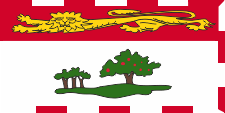 |
Provinzflagge – flag of the province, Seitenverhältnis – ratio = 1:2, Quelle/Source: Corel Draw 4   |
historische Flaggen – historical Flags: |
|
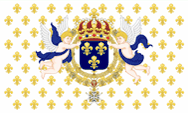 |
1534–1713, Flagge Frankreichs – flag of France, Quelle/Source, nach/by: Sodacan [CC BY-SA 3.0], via Wikimedia Commons  |
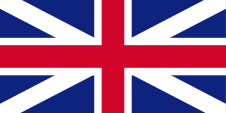 |
1713–1801, Union Flag → quasi Nationalflagge/national flag, Flagge von Großbritannien – flag of United Kingdom, Seitenverhältnis – ratio 1:2, Quelle/Source, nach/by: Die Welt der Flaggen |
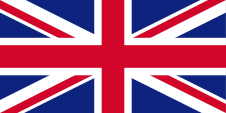 |
1801–1965, Union Flag → quasi Nationalflagge/national flag, Flagge von Großbritannien – flag of United Kingdom, Seitenverhältnis – ratio 1:2, Quelle/Source, nach/by: Wikipedia (EN), thecanadianencyclopedia.ca    |
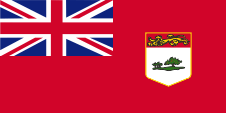 |
1878–1905, Provinzflagge – flag of the province, Seitenverhältnis – ratio = 1:2, Quelle/Source nach/by: World Statesmen |
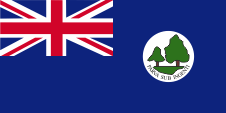 |
1905–1964, Flagge der Regierung (Staatsflagge) – flag of the government (state flag), Quelle/Source nach/by: World Statesmen |
Bedeutung/Ursprung der Flagge – Meaning/Origin of the Flag: |
|
| Die heutige Flagge der Prinz-Eduard-Insel wurde am 24.05.1964 erstmals offiziell gehisst. Es ist eine Wappenflagge, denn sie zeigt das Design des Wappens der Provinz. | The today's flag of Prince Edward Island was officially hoisted for the first time on 24th of May in 1964. It is a scutcheon flag, because it shows the design of the coat of arms of the province. |
| Normalerweise hätte die Provinz, wie alle anderen auch, keine eigene Flagge haben und nur die britische bzw. ab 1870 die kanadischen Flaggen verwenden dürfen. Dennoch hat man, wie in allen anderen Provinzen auch, eine eigene Flagge haben wollen, die, wie in allen anderen Provinzen auch, nie genehmigt wurde. Man legte sich, im Jahre 1878, offenbar und ausgerechnet einen Red Ensign zu, der das damalige Wappenschild der Provinz im wehenden Ende zeigte. Ein klarer Verstoß gegen das Ensign-System, denn ein Red Ensign wird von der britischen Admiralität zusätzlich zum Blue Ensign verliehen. | Normally the province would, like every other province too, not have
had its own flag and should only have used the British flags or, from 1870,
the Canadian flags. Nevertheless they wanted, like as in all other
provinces, to have its own flag, which, like as in all other provinces,
never was approved. They, apparently and significantly, introduced a Red Ensign in the year 1878, which showed the then coat of arms of the province in the flying end. A clear violation of the Ensign system, because a Red Ensign is always awarded by the British Admiralty in addition to the Blue Ensign. |
| Immerhin wurde 1905 der Red Ensign durch einen Blue Ensign ersetzt, der ebenfalls nie genehmigt wurde. | After all, in 1905 the Red Ensign was replaced by a Blue Ensign, which was also never approved. |
Großbritannien hatte in Jahr 1864 ein Flaggensystem eingeführt, in dem:
Seit 1865 durften Schiffe von Kolonialregierungen einen Blue Ensign mit einem Badge (Abzeichen) im fliegenden Ende führen. Die jeweiligen Regierungen sollten entsprechene Bagdes zur Verfügung stellen. Handelsschiffe und seefahrende Privatpersonen aus Kolonien dürfen nur dann einen Red Ensign mit Badge führen, wenn von der britischen Admiralität eine entsprechende Erlaubnis für die Kolonie erteilt wurde. |
United Kingdom introduced a flag system in 1864 in which:
Since 1865 ships of colonial governments were permitted to fly the Blue Ensign with a badge in the flying end of the flag. The respective governments were asked to design appropriate badges. Merchant ships and seafaring persons from colonies were only permitted to use the Red Ensign with a badge, then also named Civil Ensign, if permission has been given to the respective colony by the British admiralty. |
| Ein solches Badge war oft eine auf einer Scheibe platzierte regionale landschaftliche Darstellung, zeigte oft Schiffe, historische Begebenheiten oder konnte auch nur eine Art Logo sein. Sehr oft zeigte ein Badge zusätzlich den Namen des Landes oder auch einen Wahlspruch. Einige Besitzungen hatten aber auch schon von Anfang an ein Wappen, bzw. erhielten über die Jahre eine eigenes Wappen und das Badge wurde abgeschafft. Um ein weitgehend einheitliches Erscheinungsbild im fliegenden Ende der Flaggen zu gewährleisten, wurden Wappen und auch andere Symbole auf einer weißen Scheibe in der Größe der früheren Badges dargestellt. Es gab hier aber auch Ausnahmen, denn einige Kolonien verwendeten diese weiße Scheibe nicht, und platzierten ihr Wappen oder auch nur das Wappenschild - manchmal auch vergrößert - direkt auf das Flaggentuch. Schon in den 40-er Jahre wurde dazu übergegangen die weiße Scheibe zu entfernen und das Wappen direkt zu platzieren oder vergrößert dazustellen. Dieser Umstellungsprozess erfolgte allmählich, nirgendwo gleichzeitig und vollständig. In einigen britischen Besitzungen sind bis heute Flaggen mit der weißen Scheibe in Gebrauch, in anderen nicht mehr und in einigen Gebieten gibt es beide Varianten nebeneinander. |
Such a badge was often a regional landscape representation placed on a disk,
often showing ships, historical events or even a kind of a logo. Very often,
a badge also showed the name of the country or a motto.
Some British possessions, however, already had a coat of arms from the beginning, or their badge was replaced by a coat of arms over the years. To ensure a uniform appearance in the flying end of the flags, coats of arms and other symbols were displayed on a white disk in the size of the earlier badges. There were also exceptions, because some colonies did not use the white disk and placed their escutcheon or even coat of arms directly on the bunting, sometimes enlarged. Already in the '40s they started to remove the white disk and placed the coat of arms directly or enlarged. This conversion process was done gradually, nowhere at the same time and completely. In some British possessions, flags with the white disc are still in use, in others no more and in some areas are both variants in use, next to each other. |
| Im Zuge der allmählichen Trennung Kanadas von Großbritannien verlor der Blue Ensign als amtliches, britisches Kennzeichen seine Bedeutung und man ersetzte ihn durch neue Provinzflaggen, die von Behörden und Dienststellen der Provinzen und auch von Privatpersonen verwendet werden dürfen. So führte Prinz-Eduard-Insel 1964 die heutige Flagge ein. Dazu wurde das Bild des Wappens auf die gesamte Fläche der Flagge übertragen. Ein Verfahren, das auch bei Änderung der Provinzflaggen von Britisch-Kolumbien, Neubraunschweig und Neuschottland angewendet worden ist. Die Flagge dieser Provinz folgt somit, aus der Historie heraus, britischen Vorgaben. Es gelten: Rot = Pantone 186, Gelb = Pantone 116, Grün = Pantone 364. | In the course of the gradual separation of Canada from the United Kingdom the Blue Ensign as an official British flag lost its meaning and became replaced by new provincial flags, which may be used by authorities and departments of the provinces and also by private individuals. In this way, Prince Edward Island introduced the current flag in 1964. For this purpose, the image of the coat of arms was transferred to the entire surface of the flag. A procedure that was also used to change the provincial flags of British Columbia, New Brunswick and Nova Scotia. The flag of this province thus follows, from history, British specifications. The following apply: Red = Pantone 186, Yellow = Pantone 116, Green = Pantone 364. |
| Quelle/Source: Volker Preuß, Flaggen Enzyklopädie, World Statesmen, Die Welt der Flaggen | |
Wappen – Coat of Arms: |
|
 |
Wappen der Prinz-Eduard-Insel – escutcheon of Prince Edward Island, Quelle/Source, nach/by: Corel Draw 4 |
Bedeutung/Ursprung des Wappens – Meaning/Origin of the Coat of Arms: |
|
| Es gibt ein reguläres Wappen für die Prinz-Eduard-Insel, mit Postament, Schildhaltern, einer Wappenkrone und dem Motto. Hier dargestellt ist nur der zentrale Teil des Wappens, der Wappenschild. | There is a regular coat of arms for the Prince Edward Island, with a console, shield holders (supporters), withe a crest and the motto. Here is only depicted the central part of the coat of arms, the escutcheon. |
| Das Wappenschild der Prinz-Eduard-Insel zeigt im oberen Teil einen goldenen britischen Löwen auf rotem Grund, ein Hinweis an die Verbindungen zu Großbritannien. Darunter eine symbolische Darstellung der Insel. Das Wappen ist von einem rot-weiß gestückten Bord umgeben. | The
escutcheon of the Prince Edward Island shows in the upper part a golden British
lion on red ground, a hint at the connexions to United Kingdom. Underneath a
symbolic depiction of the island. The coat of arms is surrounded by a red
and white board. |
| Quelle/Source: Volker Preuß, Wikipedia (EN) | |
Landkarte – Map: |
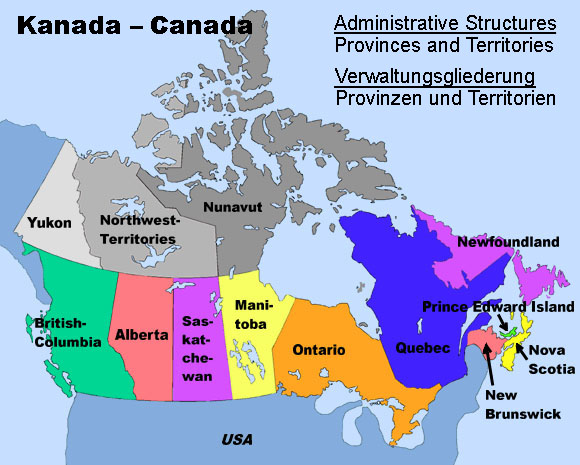 |
| Landkarte/Map: Volker Preuß |
Zahlen und Fakten – Numbers and Facts: |
|
|
|
|
|
|
|
|
|
|
|
|
|
|
|
|
|
Geschichte: |
| 1534 ·
der französische Forscher Jacques Cartier landet auf der Insel, und nimmt
die Insel für Frankreich in Besitz 1608 · Zusammenfassung aller französischen Besitzungen im heutigen Kanada als "Neufrankreich" 1663 · Neufrankreich wird französische Kronkolonie 1713 · Friede von Utrecht, Frankreich muss Neuschottland, Neubraunschweig und die Insel Neufundland an Großbritannien abtreten, die Inseln Royale (die heutige Insel Cape Breton), St. Jean (die heutige Prinz-Eduard-Insel) und St. Pierre/Miquelon bleiben jedoch französisch 1763 · Friede von Paris, Frankreich muss alle nordamerikanischen Besitzungen an Großbritannien (Britisch-Nordamerika) abtreten, außer St. Pierre und Miquelon 1784 · Umbenennung der Insel St. Jean in Prinz-Eduard-Insel, Aufteilung von Neuschottland in vier Provinzen ("Meeresprovinzen"), jedoch unter einem gemeinsamen Generalgouverneur: Neuschottland, Neubraunschweig, Kap-Breton-Insel und Prinz-Eduard-Insel, die Provinzen Kap-Breton-Insel und Prinz-Eduard-Insel werden später wieder zu Neuschottland eingezogen 1840 · Vereinigung der Provinzen Neuschottland, Neubraunschweig, Québec und Ontario zu einer Kolonie (Kanada) mit einer eigener Verfassung 1867 · Gründung der Konföderation Kanada (Dominion of Canada – mit einem eigenen Parlament) auf Grund von Autonomieforderungen, Konföderation durch die vier Gründungsprovinzen Neubraunschweig, Québec, Ontario und Neuschottland 1873 · erneute Gründung der Provinz Prinz-Eduard-Insel durch Ausgliederung aus Neuschottland, Beitritt zum Dominion of Canada |
History: |
| 1534
· the French explorer Jacques Cartier lands on the island and takes
possession of the island for France 1608 · summary of all French possessions in the today's Canada under the name "New France" 1663 · New France (including St. Jean Island) becomes French crown colony 1713 · Peace of Utrecht, France has to cede the today's New Brunswick, Nova Scotia and the Island of Newfoundland to United Kingdom, however, the Islands of Royale (today's Cape Breton Island), St. Jean (today's Prince Edward Island) and St. Pierre / Miquelon remain French 1763 · Peace of Paris, France has to cede all its north american possessions to United Kingdom (British Northern America), except St. Pierre and Miquelon 1784 · division of Nova Scotia into four provinces ("sea provinces"), however under one common Governor General: Nova Scotia, New Brunswick, Cape Breton Island and Prince Edward Island, the provinces Cape Breton Island and Prince Edward Island get later re-annexed to Nova Scotia 1840 · union of the provinces of Nova Scotia, New Brunswick, Québec and Ontario in one colony (Kanada) with an own constitution 1867 · establishment of the Confederation of Canada (Dominion of Canada – with an own parliament) because of demands for autonomy, confederation by the four founding provinces New Brunswick, Québec, Ontario and Nova Scotia 1873 · re-founding of the province of Prince Edward Island by outsourcing from Nova Scotia, joining the Dominion of Canada |
| Quelle/Source: Atlas zur Geschichte, World Statesmen, Wikipedia (D), Discovery '97 |
Ursprung des Landesnamens – Origin of the Country's Name: |
|
| Nachdem Großbritannien im Jahre 1713 die Herrschaft von Frankreich übernommen hatte, wurde die Insel St. Jean, benannt nach dem Heiligen Johannes im Jahre 1784 in Prinz-Eduard-Insel umbenannt. Benannt wurde Sie nach Prince Edward Augustus, den Herzog von Kent und Strathearn, vierter Sohn von König Georg III. von Großbritannien, Irland und Hannover, und von Königin Charlotte, Vater von Königin Victoria. |
After Britain had taken over the reign
from France in 1713, the island of St. Jean – named after St. Johannes – was
renamed in 1784 in Prince Edward Island. It is named after Prince Edward Augustus, Duke of Kent and Strathearn, fourth son of King George III. of United Kingdom, Ireland and Hanover, and from Queen Charlotte, father of Queen Victoria. |
| Quelle/Source: Volker Preuß | |